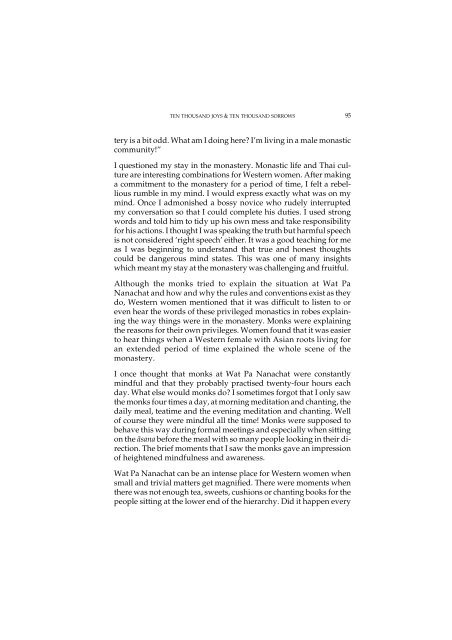Forest Path - Amaravati Buddhist Monastery
Forest Path - Amaravati Buddhist Monastery
Forest Path - Amaravati Buddhist Monastery
You also want an ePaper? Increase the reach of your titles
YUMPU automatically turns print PDFs into web optimized ePapers that Google loves.
ten thousand joys & ten thousand sorrows 95<br />
tery is a bit odd. What am I doing here? I’m living in a male monastic<br />
community!”<br />
I questioned my stay in the monastery. Monastic life and Thai culture<br />
are interesting combinations for Western women. After making<br />
a commitment to the monastery for a period of time, I felt a rebellious<br />
rumble in my mind. I would express exactly what was on my<br />
mind. Once I admonished a bossy novice who rudely interrupted<br />
my conversation so that I could complete his duties. I used strong<br />
words and told him to tidy up his own mess and take responsibility<br />
for his actions. I thought I was speaking the truth but harmful speech<br />
is not considered ‘right speech’ either. It was a good teaching for me<br />
as I was beginning to understand that true and honest thoughts<br />
could be dangerous mind states. This was one of many insights<br />
which meant my stay at the monastery was challenging and fruitful.<br />
Although the monks tried to explain the situation at Wat Pa<br />
Nanachat and how and why the rules and conventions exist as they<br />
do, Western women mentioned that it was difficult to listen to or<br />
even hear the words of these privileged monastics in robes explaining<br />
the way things were in the monastery. Monks were explaining<br />
the reasons for their own privileges. Women found that it was easier<br />
to hear things when a Western female with Asian roots living for<br />
an extended period of time explained the whole scene of the<br />
monastery.<br />
I once thought that monks at Wat Pa Nanachat were constantly<br />
mindful and that they probably practised twenty-four hours each<br />
day. What else would monks do? I sometimes forgot that I only saw<br />
the monks four times a day, at morning meditation and chanting, the<br />
daily meal, teatime and the evening meditation and chanting. Well<br />
of course they were mindful all the time! Monks were supposed to<br />
behave this way during formal meetings and especially when sitting<br />
on the àsana before the meal with so many people looking in their direction.<br />
The brief moments that I saw the monks gave an impression<br />
of heightened mindfulness and awareness.<br />
Wat Pa Nanachat can be an intense place for Western women when<br />
small and trivial matters get magnified. There were moments when<br />
there was not enough tea, sweets, cushions or chanting books for the<br />
people sitting at the lower end of the hierarchy. Did it happen every

















